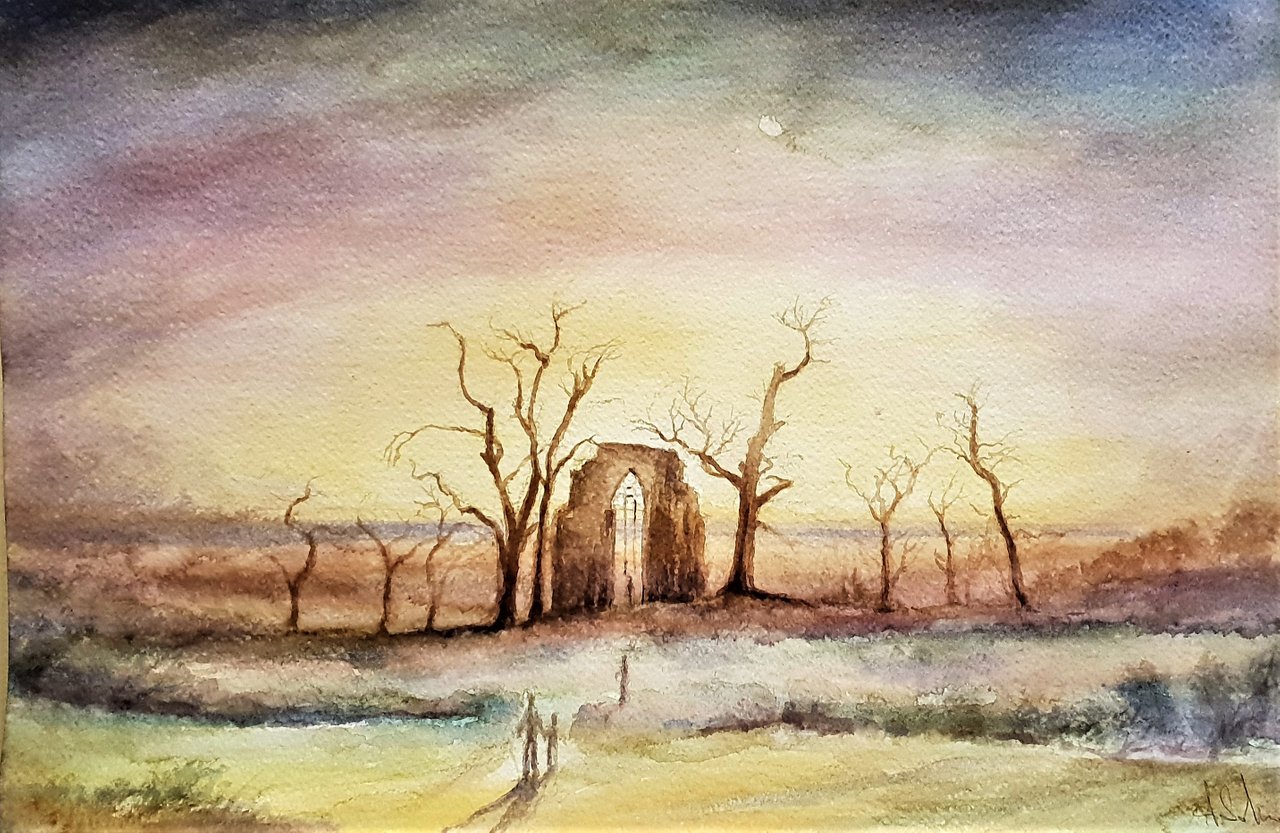
Abbey in the oakwood

2 0 1 9
watercolor on paper

A lessons in the classroom:


Today, starting from my watercolor inspired by a work of art by the great artist David Caspar Friedrich, I will deepen the picture of the great Romantic artist through the analysis of the key elements.
In my teaching profession, often, during the teaching activities, I propose to my students the reproductions of great artists and today I share with you my typical lesson.
The observation of a work of art is the best source of teaching that exists, especially if guided and routed towards the realization of a new painting or drawing.
In the teaching method, the observation precedes, the analysis and subsequently, the pupil will produce a thoughtful and in-depth elaboration.
When we study a period of art history, as in our case, Romanticism is a good solution for a better and complete learning, to try to make a work of an artist belonging to the current one.
In this case Friedrich!
I proposed this work because he is perhaps the greatest exponent of Romanticism in Painting.
Let's analyze the work of art:
An ancient Abbey, of which only part of the main facade remains, on which there is a gothic style single-light window.
It is surrounded by a desolate and bare oak, mysterious and gloomy.
The appearance is made even more sinister by a cemetery, where several crosses underline the presence of death.

I highlighted the most interesting points of the work of art.

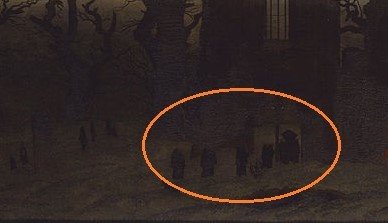.jpg)
- 1 Some friars taking part in a funeral and carrying the relics of their dead brother.

- 2 Unstable crosses appear from the ground.
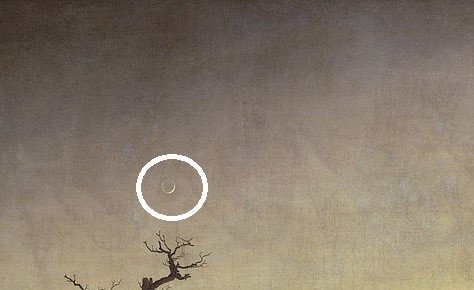.jpg)
- 3 The sickle-shaped moon alludes to the end of a cycle.
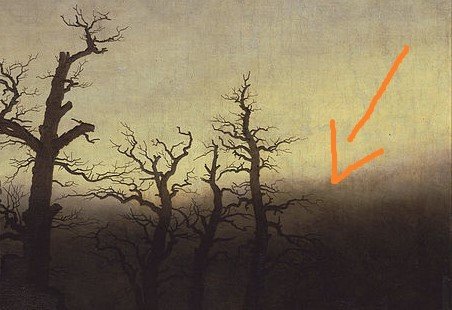.jpg)
- 4 a soft and spectral dawn, cold.

- 5 The monofora with three circles referred to the Christian Trinity. The decadence of the abbey represents a harsh criticism of ecclesiastical institutions.
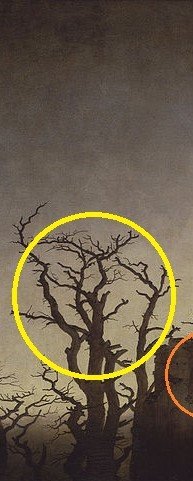.jpg)
- 6 the oaks with their twisted and dry branches, symbol of a pagan past of humanity. It is noteworthy that the artist has chosen an immortal tree like the oak to witness the path of the disintegration of all things, and of the end of life, a very deep feeling typical of Romanticism.


The sense of death pervades the whole scenario, Friedrich in this work becomes the spokesman of the discomfort that lives in the early nineteenth century. this veiled pessimism expands it in all the elements of the landscape.
The substance of the crosses is the same as the friars, skeletons, oaks and crosses are all part of human transience and of things.
A well-defined historical and artistic period, where the sense for the immensity of Nature blends with the anguish of man, small and helpless, in the face of ineluctable phenomena such as THE DEATH.
A big embrace of light.
Armando.

Una mia lezione in aula:


Oggi, partendo da un mio acquarello ispirato da un' opera d'arte del grande artista David Caspar Friedrich, approfondirò il quadro del grande artista Romantico attraverso l'analisi degli elementi chiave.
Nella mia professione di insegnante, spesso, durante le attività didattiche, propongo ai miei studenti delle riproduzioni di grandi artisti e oggi condivido con voi una mia lezione tipo.
L'osservazione di un opera d'arte è la migliore fonte di insegnamento che esiste, soprattutto se guidata e instradata verso la realizzazione di un nuovo dipinto o disegno.
Nel metodo di insegnamento, l'osservazione precede, l'analisi e successivamente, l'alunno produrrà una elaborazione meditata e approfondita.
Quando studiamo un periodo di storia dell'arte, come nel nostro caso, il Romanticismo, è una buona soluzione per un migliore e completo apprendimento, cercare di realizzare un opera di un artista appartenente a quella corrente.
In questo caso Friedrich!
Ho proposto quest'opera perchè egli è forse il massimo esponente del romanticismo in Pittura.
Analizziamo l'opera d'arte:
Una antica Abbazia, della quale resta solo parte della facciata principale, sulla quale è presente una monofora in stile gotico.
Essa è circondata da un querceto desolato e spoglio, misterioso e cupo.
L'aspetto è reso ancora più sinistro da un cimitero, dove diverse croci sottolineano la presenza della morte.

Ho evidenziato i punti più interessanti dell'opera d'arte.
.jpg)
- 1 Alcuni frati che partecipano ad un funerale e trasportano le reliquie del loro fratello morto.

- 2 Croci instabili che appaiono dal terreno.
.jpg)
- 3 La luna a forma di falce, allude alla fine di un ciclo.
.jpg)
- 4 Un alba tenue e spettrale, fredda.

- 5 La monofora con tre cerchi riferito alla Trinità cristiana. La decadenza dell'abbazia rappresenta una aspra critica verso le istituzioni ecclesiastiche.
.jpg)
- 6 le querce con i loro rami contorti e secchi, simbolo di un trascorso pagano dell'umanità. E' da notare che l'artista abbia scelto un albero immortale come la quercia a testimoniare il percorso del disfacimento di tutte le cose, e della fine della vita, un sentimento molto profondo e tipico del Romanticismo.


Il senso della morte, pervade tutto lo scenario, Friedrich in quest'opera si fa portavoce del disagio che vive l'uomo dei primi anni dell'Ottocento. questo velato pessimismo egli lo espande in tutti gli elementi del paesaggio.
La sostanza delle croci è la stessa dei frati, scheletri, querce e croci sono tutti parte della caducità umana e delle cose.
Un periodo storico e artistico ben definito, dove il senso per l'immensità della Natura si fonde con le angosce dell'uomo, piccolo e inerme, davanti a fenomeni ineluttabili come LA MORTE.
Vi mando un grande abbraccio di luce.
Armando.


- Art teacher
- Curator of cultural activities
- Artistic director and President of the Cultural Association "I Colori della Vita"

